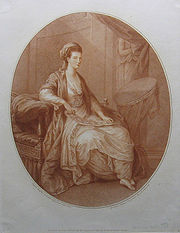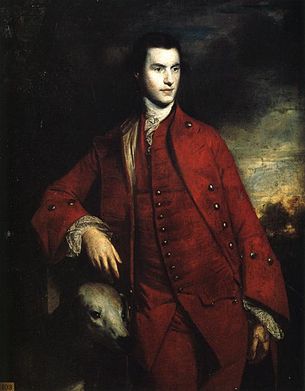- Charles Lennox, 3rd Duke of Richmond
-
Field Marshal His Grace
The Duke of Richmond
KG PC FRS
Portrait by George Romney, circa 1777 Secretary of State for the Southern Department In office
23 May 1766 – 29 July 1766Monarch George III Prime Minister The Marquess of Rockingham Preceded by Henry Conway Succeeded by The Earl of Shelburne Personal details Born 22 February 1735 Died 29 December 1806 (aged 71) Spouse(s) Mary Bruce Military service Allegiance  Kingdom of Great Britain
Kingdom of Great BritainService/branch  British Army
British ArmyYears of service 1751-1806 Rank Field Marshal Commands 72nd Regiment of Foot, Colonel
Royal Horse Guards, ColonelBattles/wars Seven Years' War Awards Knight of the Garter Field Marshal Charles Lennox, 3rd Duke of Richmond, 3rd Duke of Lennox, 3rd Duke of Aubigny, KG, PC, FRS (22 February 1735 – 29 December 1806), styled Earl of March until 1750, was a British politician and office holder noteworthy for his advanced views on the issue of parliamentary reform. He associated with the Rockingham Whigs and rose to hold the post of Southern Secretary.
Contents
Career
Lennox was styled Earl of March, his father's principal subsidary title, from birth, his early education was had at Westminster School and he succeeded his father as Duke of Richmond and Lennox in 1750.[1] He had many sisters, including the Ladies Caroline Lennox, Emily Lennox, Louisa Lennox and Sarah Lennox. He was admitted a Fellow of the Royal Society on 11 December 1755.[2]
Richmond was commissioned in the 2nd Foot Guards in 1751.[1]
From 1756 to 1758 Richmond was the lieutenant-colonel of the 33rd Regiment of Foot.[1] In 1757 a second battalion (2nd/33rd) had been raised and in 1758 this battalion became an independent regiment, the 72nd Regiment of Foot: Richmond was appointed Colonel of the new regiment[1] and his younger brother George Lennox took command of the 33rd Regiment (1st/33rd).
He took part in the Raid on Cherbourg in 1758 and the Battle of Minden in 1759.[1] The 72nd Regiment was disbanded in 1763 at the end of the Seven Years' War.[3]
The Duke of Richmond was appointed British ambassador extraordinary in Paris in 1765,[1] and in the following year he briefly served as Southern Secretary in the Rockingham Whig administration,[1] resigning office on the accession to power of The Earl of Chatham.
 Mary, Duchess of Richmond, by William Wynne Ryland after Angelica Kauffmann
Mary, Duchess of Richmond, by William Wynne Ryland after Angelica Kauffmann
In the debates on the policy that led to the War of American Independence Richmond was a firm supporter of the colonists,[1] and he initiated the debate in 1778 calling for the removal of the troops from America, during which Chatham was seized by his fatal illness.[1] He also advocated a policy of concession in Ireland, with reference to which he originated the phrase "a union of hearts" which long afterwards became famous when his use of it had been forgotten. In 1779 the duke brought forward a motion for retrenchment of the civil list; and in 1780 he embodied in a bill his proposals for parliamentary reform, which included manhood suffrage, annual parliaments and equal electoral areas.[1]
Richmond sat in Rockingham's second cabinet as Master-General of the Ordnance,[1] and in 1784 he joined the ministry of William Pitt. He now developed strongly Tory opinions, and his alleged desertion of the cause of reform led to a violent attack on him by Lauderdale in 1792, which nearly led to a duel between the two noblemen. Richmond died in December 1806, and, leaving no legitimate children, he was succeeded in the peerage by his nephew Charles, son of his brother, General Lord George Henry Lennox. The adjoining towns of Richmond and Lenox in Massachusetts were named in his honor.
He became a Privy Counsellor in 1765.
In retirement he built the famous racecourse at his the family seat at Goodwood.[1] He was also a patron of artists such as George Stubbs, Pompeo Batoni, Anton Raphael Mengs, Joshua Reynolds, George Romney and George Smith of Chichester.[4]
Ancestry
Ancestors of Charles Lennox, 3rd Duke of Richmond 16. Charles I of England 8. Charles II of England 17. Henrietta Maria of France 4. Charles Lennox, 1st Duke of Richmond 18. Guillaume de Penancoët, Seigneur de Kérouaille 9. Louise Renée de Penancoët de Kérouaille, Duchess of Portsmouth 19. Marie de Ploeuc de Timeur 2. Charles Lennox, 2nd Duke of Richmond 20. Robert Brudenell, 2nd Earl of Cardigan 10. Francis Brudenell, Lord Brudenell 21. Anne Savage 5. Anne Brudenell 22. Thomas Savile, 1st Earl of Sussex 11. Frances Savile 23. Anne Villiers 1. Charles Lennox, 3rd Duke of Richmond 24. William Cadogan 12. Henry Cadogan 25. Elizabeth Roberts 6. William Cadogan, 1st Earl Cadogan 26. Hardress Waller 13. Bridget Waller 27. Mary (Elizabeth) Dowdall 3. Sarah Cadogan 28. Joan Munter 14. Jan Munter 29. Margaretha Geelvinck 7. Margaret Cecilia Munter 30. Hendrick Trip 15. Margaretha Trip 31. Cecilia Godin External links
- Charles Lennox, 3rd Duke of Richmond at Genealogics
- Duke of Richmond @ Spartacus
References
- ^ a b c d e f g h i j k l Oxford Dictionary of National Biography
- ^ "Lists of Royal Society Fellows". http://www.royalsoc.ac.uk/page.asp?id=1727. Retrieved 2006-12-15.
- ^ History of the Duke of Wellington's Regiment, (page 41), Brereton / Savoury, ISBN 0952155206
- ^ Goodwood House painting collection.
 This article incorporates text from a publication now in the public domain: Chisholm, Hugh, ed (1911). Encyclopædia Britannica (11th ed.). Cambridge University Press.
This article incorporates text from a publication now in the public domain: Chisholm, Hugh, ed (1911). Encyclopædia Britannica (11th ed.). Cambridge University Press.
Categories:- 1735 births
- 1806 deaths
- 33rd Regiment of Foot officers
- British Field Marshals
- Coldstream Guards officers
- Deputy Lieutenants of the Tower Hamlets
- Diplomatic peers
- Dukes of Lennox
- Dukes of Richmond
- Dukes of Aubigny
- Earls of March (1675)
- Fellows of the Royal Society
- Knights of the Garter
- Lancashire Fusiliers officers
- Lord-Lieutenants of Sussex
- Members of the Privy Council of Great Britain
- Old Westminsters
- Royal Horse Guards officers
- Secretaries of State for the Southern Department
- Ambassadors of Great Britain to France
Wikimedia Foundation. 2010.

